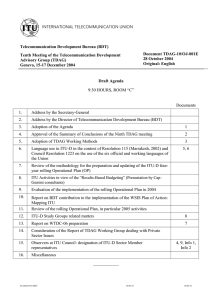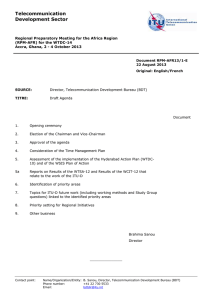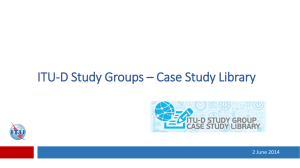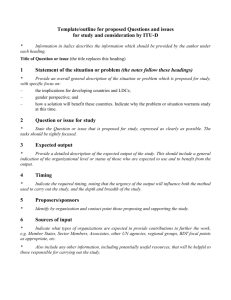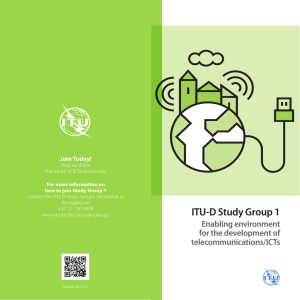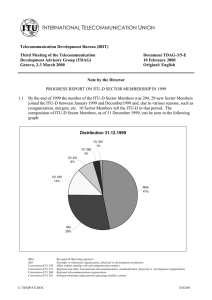INTERNATIONAL TELECOMMUNICATION UNION Telecommunication Development Bureau (BDT) Document TDAG-2/5-E
advertisement
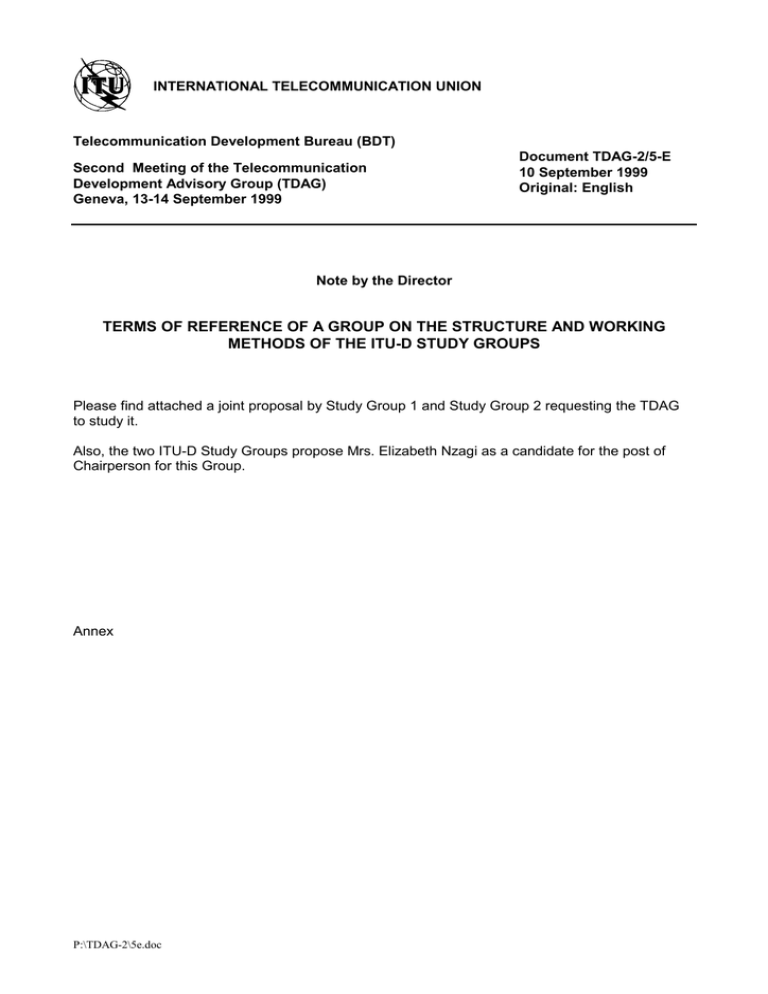
INTERNATIONAL TELECOMMUNICATION UNION Telecommunication Development Bureau (BDT) Second Meeting of the Telecommunication Development Advisory Group (TDAG) Geneva, 13-14 September 1999 Document TDAG-2/5-E 10 September 1999 Original: English Note by the Director TERMS OF REFERENCE OF A GROUP ON THE STRUCTURE AND WORKING METHODS OF THE ITU-D STUDY GROUPS Please find attached a joint proposal by Study Group 1 and Study Group 2 requesting the TDAG to study it. Also, the two ITU-D Study Groups propose Mrs. Elizabeth Nzagi as a candidate for the post of Chairperson for this Group. Annex P:\TDAG-2\5e.doc 2 TDAG-2/5-E ANNEX 1 Terms of Reference 1. Present situation Apart from CV and CS, at present the provisions for ITU-D Study Groups are contained in 3 documents, namely Terms of Reference of ITU-D Study Groups and Procedures to be applied by ITU-Study Groups in revised Resolutions 3 and Resolution 4 (WTDC-98), and Guidelines for the work of the Rapporteurs with their extended role in the ITU-D Study Groups as approved by TDAG in its April 1999 meeting (Document 1/043-2/059). 2. Areas for improvement Experience shows that further improvements are needed - among others - in the following areas: Reduction of the cost and volume of documentation (Resolution 1141) Clear guidance on the principles to be followed for translation, reproduction and distribution of documents for Study Group or other Group’s meetings should be provided. In the light of Resolution 1141 and the Annex to Resolution 104 (Minneapolis, 1998) existing provisions may need to be revised or new provisions may be established. Numbering of Documents, follow-up procedures An increasing number of meeting is going to take place within the framework of ITU-D Study Groups. A numbering protocol (e.g. CHAIR/xxx for Management Team meetings) and principle (e.g. continued numbering) is needed as well as the use of different colours to identify the status of a document. Rapporteur’s progress reports, Reports of meetings, Liaison statements There is no systematic reporting in between the Study Group meetings. The need arises to define the frequency of Rapporteur’s progress reports to indicate their processing. This will help Chairpersons and BDT Secretariat to better organise and follow the work of the Question. Resolution 4 (WTDC-98) and the Guidelines for Rapporteurs may need further alignment e.g. concerning reports of meetings. More clarification is needed with respect to addressing of liaison statements (to whom should they be addressed, by whom should they be sent). Some elaboration is needed concerning the processing of incoming liaison statements from the other two Sectors. Rapporteur’s Group meetings Some minimum requirements needs to be defined (e.g. number of participants, notice time, number of contributions). Electronic document handling and on-line discussion methods The increased use of electronic document handling (EDH) and the development of on-line discussion methods require guidelines for the document flow. Documents received by the Study Group secretariat are incompatible with the software used at ITU, pictures in particular cause problems and delay the production of a document. Reference document P:\TDAG-2\5-E 3 TDAG-2/5-E The above-mentioned items, combined with documentation related to the definition of Questions and references to Articles of the ITU Constitution and Conventions as well as Resolutions and Recommendations of World Telecommunication Development Conferences and Plenipotentiary Conferences, could be gathered in one single reference document, to be updated as and when required. The BDT Secretariat has presented a first draft structure to the present Study Group meeting (see Document 1/044-2/063). Titles of the Study Groups During the World Telecommunication Development Conference 1998, the titles of the two Study Groups were not defined. It might be necessary to give a title to each Study Group. 3. Establishment of a Group Considering the above, the ITU-D Study Groups propose to TDAG •= to establish a Group, comprising representatives from among the two Study Group Management Teams, Associate Rapporteurs and other collaborators, as well as staff from the Study Group Secretariat; •= to agree a timetable of working sessions in order to present an interim report to the next meeting of the Telecommunication Development Advisory Group in February 2000; •= to make sure that the final report of the Group will be presented to the Director of the Telecommunication Development Bureau in time for action by the World Telecommunication Development Conference in 2002. 4. Mandate The working methods of ITU-R and ITU-T Study Groups may be a basis for establishing more detailed working methods for ITU-D Study Groups, however, taking into account the specific nature and resources of the Development Study Groups as well as the provisions of CV and CS relevant to ITU-D Study Groups. Taking into consideration, (a) Resolution 82 (PP-98, Minneapolis); (b) the experience gained so far in ITU-R, ITU-T, and particularly in ITU-D; (c) the issues enumerated under item 2 of this document, and the need to elaborate more detailed working methods; The mandate of the Group is to propose 1) a consolidated documentation for issues related to ITU-D Study Groups, and 2) a report to TDAG according to the timetable agreed. __________ P:\TDAG-2\5-E
